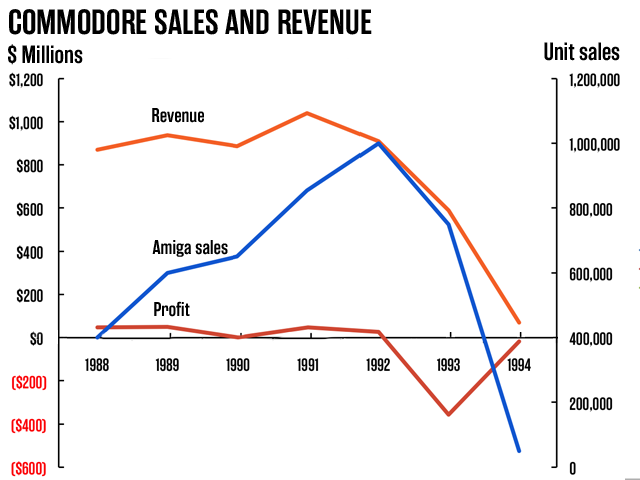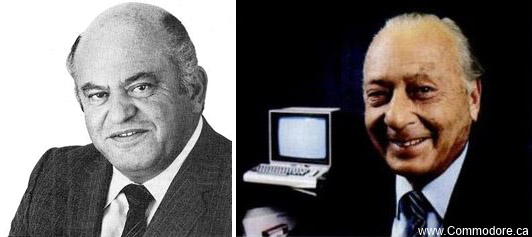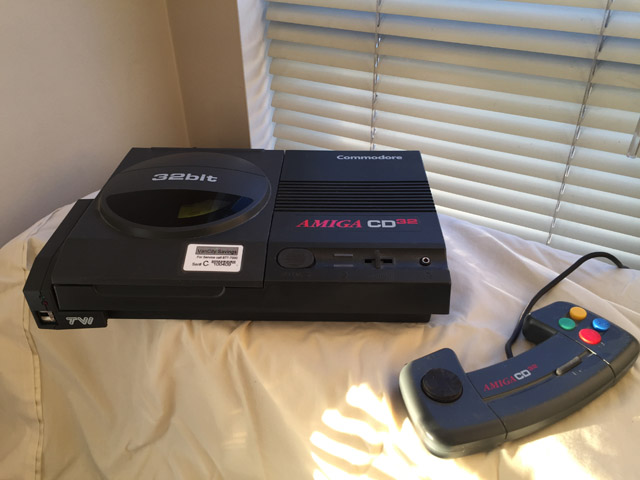
As the 1990s began, Commodore should have been flying high. The long-awaited new Amiga models with better graphics, the A1200 and A4000, were finally released in 1992. Sales responded by increasing 17 percent over the previous year. The Video Toaster had established a niche in desktop video editing that no other computer platform could match, and the new Toaster 4000 promised to be even better than before. After a rocky start, the Amiga seemed to be hitting its stride.
Unfortunately, this success wouldn’t last. In 1993, sales fell by 20 percent, and Commodore lost $366 million. In the first quarter of 1994, the company announced a loss of $8.2 million—much better than the previous four quarters, but still not enough to turn a profit. Commodore had run into financial difficulties before, particularly in the mid-'80s, but this time the wounds were too deep. Sales of the venerable Commodore 64 had finally collapsed, and the Amiga wasn’t able to fill the gap quickly enough. The company issued a statement warning investors of its problems, and the stock plunged. On April 29, 1994, Commodore International Limited announced that it was starting the initial phase of voluntary liquidation of all of its assets and filing for bankruptcy protection. Commodore, once the savior of the Amiga, had failed to save itself.

What went wrong
Why did this happen? Was it inevitable, or could the company have made different choices and kept both itself and the Amiga platform alive and healthy?
There are those who would argue the former. Computing platforms tend to start with many different competitors and then slowly dwindle down to one or two survivors. IBM so dominated the mainframe industry in the 1960s that it was referred to as “Snow White," with more market share than the “Seven Dwarves” combined. Those seven became five and then essentially one after mergers and acquisitions. There were more than 100 personal computer platforms in the early '80s, but by 1994 only two remained that sold enough to be measurable: PC compatibles at 91 percent share and Macintoshes at 9 percent. More recently, we’ve seen a diverse market of smartphone platforms whittled down to leave just two: Android at 88 percent and iPhones at 12 percent.
But is the survival of more than two computing platforms an ironclad law of technology or just a coincidence? There are exceptions—game consoles went through two separate generations with three viable competitors: Nintendo, Sega, and Sony in the 1990s, and Nintendo, Microsoft, and Sony from the 2000s until present-day. In addition, a declining market share is not irreversible. The Macintosh, after hitting a low of under two percent in 2003, has since rebounded to a healthy 7.5 percent. Could a trio of PCs, Macintoshes, and Amigas have coexisted in an alternate universe?
I think so. Saving the Amiga wouldn’t have been easy, but it definitely was possible. Ultimately, the failure rests with Commodore management, who not only failed to adapt to a changing marketplace, but in many cases were actively hostile to their own company. To understand what they did and why they did it, we have to jump far back in time—to the creation of Commodore itself.
Jack Tramiel sells his soul
Jack Tramiel founded Commodore in 1955, leveraging his experiences repairing typewriters after the war to build up a small stable of office products, including adding machines. Jack was a Holocaust survivor, and his aggressive, take-no-prisoners approach to business sometimes got him in trouble. In 1965, he was involved in a scandal when the Alliance Acceptance Corporation, a Canadian financial company, suddenly collapsed. Tramiel had close ties to Alliance, and although he was not indicted, the scandal wrecked Commodore. To survive, Tramiel was forced to sell a large share of his company to Irving Gould, a Canadian financier. Gould now held the purse strings.

Irving Gould was a jet-setting man who didn’t like to spend a lot of time managing the company, preferring instead to let Tramiel handle the day-to-day operations while he took care of the finances. For a while, this strategy worked well. The purchase of MOS Technologies (the company that made the legendary 6502 CPU that powered most 8-bit computers), the release of the PET, and the success of the VIC-20 and Commodore 64 all happened during this time.
However, Gould grew increasingly intolerant of Tramiel’s one-man management style. Tramiel also said that he wanted to issue more stock to pay off Commodore’s massive debts, but Gould refused, arguing that it would weaken his hold on the company. What Gould didn’t say was that much of Commodore’s debt was to other companies that Gould also controlled.
Their disagreements came to a head when Tramiel criticized Gould for using Commodore’s assets (such as the company jet) for personal reasons. Jack said: “You can’t do this while I’m president,” to which Gould responded, “Goodbye.”
Gould then arranged to force Tramiel out of his own company while forming a series of increasingly flimsy excuses: first that although Jack had brought the company to its first billion in sales, he wasn’t the one to get them to ten billion. Then, he believed that Jack was trying to position his sons to take over the company.
In any case, Gould managed to get Tramiel to suddenly resign from the company he founded in 1984. Without Jack, Commodore had lost its soul, much as Apple had when Steve Jobs was kicked out. Gould then proceeded to hand-pick a series of CEOs with little or no experience in the personal computing industry. Some, like Marshall Smith, were terrible, whereas others, like Thomas Rattigan, managed to bring the company back to profitability. One thing was consistent, however: Commodore CEOs, like hockey coaches, were hired to be fired.
Gould was out of his element, so in 1986 he turned to what many incompetent and desperate managers utilize: a management consulting company. The company he hired, Dillon-Read, sent over a managing director named Mehdi Ali. Ali spent many years and many millions of dollars to come up with the recommendation that Gould should hire Mehdi Ali to be the new CEO of Commodore International, which Gould finally did in 1989. This was the exact moment when Commodore sealed its doom.
Mehdi’s mistakes
Ali’s reign at Commodore can be characterized by three main aspects: costly strategic errors, cutting essential research and development (R&D), and increasing the CEO’s compensation. The latter was no small thing. In 1989, Ali received $1.38 million in salary. In 1990, that figure rose to $2 million (not including bonuses), and Irving Gould scored a 40 percent pay raise to $1.75 million. By comparison, the CEO of IBM, John Akers, received $713,000 in the same year.
Mehdi missed or flubbed several key opportunities during this time. One of the most egregious was killing a deal with Sun Microsystems, which wanted to license both Amiga Unix (AMIX) and Amiga hardware for their low-end workstations. Ali sabotaged the deal twice by demanding increasingly outrageous licensing fees.
Ali sat back and watched as new companies grew faster and faster by filling in the gaps in Amiga hardware that Commodore refused to provide, such as hard drives and CPU upgrades. The largest of these, GVP, ended up being worth over half the value of Commodore itself, which was unheard of for a peripheral company. Those were all dollars that could have gone directly into Commodore’s pocket.
Mehdi was also responsible for producing the worst Amiga ever created—the Amiga 600. Intended to be a cost-reduced 500, it was released with fewer features than its cousin for a higher price. Ali doubled down on this failure by making sure that stores were flooded with A600s that nobody wanted while failing to manufacture enough A500s and A1200s that people actually did.

But the greatest harm that Ali inflicted on Commodore was selling its future. Over the years, he continued to gut R&D funding until there was almost nothing left.
At its announcement in 1985, the Amiga was years ahead of its time. It had features like preemptive multitasking, a color GUI, and hardware graphics and sound acceleration that would not become mainstream on computers until over a decade later. However, the team that created the Amiga was keenly aware that it should be continually improved. Jay Miner, the designer of the Amiga’s chipset, had nearly completed an updated version of the chips codenamed “Ranger” that increased speed, resolution, and color support. Bizarrely, Commodore never shipped these advances, instead opting for a much less powerful spec bump on the Amiga 500 and 2000 (the Enhanced Chip Set, or ECS). But the company did start work on a huge revamp of the Amiga chipset in 1988 called the Advanced Amiga Architecture, or AAA.
AAA was a bold step forward for the Amiga, but it did not fare well in the hands of Ali’s cost-cutting. By the time Commodore folded in 1994, there was only a single engineer working on it, and it was still not ready for release. In the meantime, a stopgap solution called Advanced Graphics Architecture (AGA) had to be rushed into production, and like most things rushed into production, it was also late. Commodore management made things even worse by cancelling Dave Haynie’s A3000+ with AGA project in early 1991 in favor of the A4000, which ended up being an inferior design. Unfortunately, AGA was missing a key feature that was starting to turn the once-lowly PC into a gaming powerhouse.
The coming DOOM
The PC became a gaming contender with the release of a new three-letter graphics standard: VGA. VGA didn’t have any fancy acceleration, but it did have a standard mode called 13h, which delivered 320x200 resolution in 256 colors.
The ECS Amiga chipset could theoretically display 4,096 colors simultaneously in HAM mode, but this mode was too slow for action games. Amiga games typically used 320x200 resolution in 32 colors instead.
The AGA chipset “fixed” this issue by increasing the memory size and allowing 256 color modes, so in theory it could have competed with VGA. But VGA was available in 1987 with the IBM PS/2 computers and had become widespread in clones by 1990, whereas AGA wasn’t available until 1992. AGA also had a problem that was starting to become an issue with games: it addressed each of its pixels using planar, rather than chunky, color modes.
Planar access divides up color bits among several “planes”—think layers in Photoshop—that can be accessed separately. In the days before 256 colors, this saved huge amounts of video RAM, which was at a premium. When combined with chips like the blitter, it also made it really easy to create side-scrolling arcade games with multiple “parallax” layers that moved smoothly at different speeds. The PC architecture, even with the new VGA cards, had a difficult time doing this.

But a little shareware game came out in 1993 that made every single side-scrolling arcade game seem obsolete overnight. It was DOOM, and it used all 256 colors in VGA’s chunky modes (including a new undocumented 320x240x256 mode) to create a simulation of a 3D world. It wasn’t full 3D, of course, but it was a quantum leap for gamers. Games like DOOM used powerful 386 and 486 CPUs to make up for the lack of graphical acceleration. The Amiga, for so long the gold standard of gaming, needed a DOOM, but it couldn’t have it. It didn’t have the right graphics hardware. The fix (adding chunky modes to the chipset) wasn’t difficult, but it wasn’t available. Instead, it was shoehorned into a new Hail-Mary product that was intended to save the company and almost did.
The CD32
The CD was invented as a digital audio storage format in 1982 in a collaboration between electronics giants Philips and Sony. It took the music world by storm, and in 1984 Sony and Denon demonstrated the first CD-ROM, which gave a personal computer a read-only storage capacity of 540 megabytes. As most games were distributed on floppy disks of a single megabyte at the time, this was a ludicrous amount of storage, and companies struggled to come up with ideas for new types of content and hardware to play it on.
Philips, after many delays, released its CDi device, which looked like a regular CD player but cost $700. It was a huge commercial failure, remembered today only for an improbably terrible series of Zelda games.

Commodore had also decided to get on this bandwagon, and it had actually beat Philips to the punch when it released the CDTV in 1991. It was essentially an Amiga 500 with a CD-ROM drive in a similar plain rectangular box. These devices were met with confusion by the general public— they weren’t computers, because they had no keyboards, but they weren’t game consoles either (although the CDTV did play a mean game of Lemmings), because they were sold without game controllers and were priced prohibitively high for that market. The CDTV also failed, but it set the stage for Commodore’s final product, the CD32.
This device would be a game console, pure and simple. Commodore attempted to one-up Sega (who had struggled with the Sega CD add-on to the underpowered Genesis) by designing the console to look very similar to a Genesis, but with “32-BIT” replacing that system’s “16-BIT” designation in proud white letters. Inside was essentially an Amiga 1200 with a CD-ROM drive and a new chip called “Akiko” that added MPEG 2 movie playback and chunky-to-planar graphics conversion.
It still wasn’t quite enough for DOOM, however. The CD32 had a low-power 68EC020 CPU running at 14 MHz with very slow memory. This was about equivalent to a 386 at the same speed, which hadn’t been cutting-edge since 1990. Some games, like Wing Commander, were converted to run on the CD32, but DOOM never made it. Instead, and somewhat ironically, it was ported to the Jaguar game console, the last piece of hardware that Atari ever made.
Still, the CD32 was a very respectable game machine for its time, and it was scheduled to be released before Christmas 1993 for $399. Unfortunately, Commodore had run out of time and money.

Death by XOR
As Commodore approached its final Christmas season, it was having trouble negotiating with its parts suppliers. Years of being behind on payments were starting to take their toll, and Commodore could only procure enough parts to make 100,000 CD32s. As Dave Haynie noted in his Deathbed Vigil video, they might have survived with 400,000.
The CD32 was released in Europe and in Canada, but Commodore was unable to sell it in the United States due to a legal injunction for non-payment of patent royalties to a company called Cad Track. This was an early example of a patent troll, as the patent was for using the simple Boolean XOR (exclusive OR) formula for displaying computer graphics. XOR is a fast way to overlap graphics non-destructively and was commonly used by GUIs to draw bounding boxes. Every other computer company simply paid Cad Track their royalties as a matter of course, but Commodore had defaulted on payments and had refused to pay the $10 million penalty ordered by a US judge. At this time Mehdi Ali was still taking home more than $2 million a year.
The CD32 sold all 100,000 units in Europe and Canada, but Commodore had no money to make any more. The market for the consoles collapsed after Commodore’s liquidation, but some of them found some innovative uses: for example, a company in Vancouver created the first online banking application for Vancity using CD32s and custom-built add-on modems.
reader comments
505